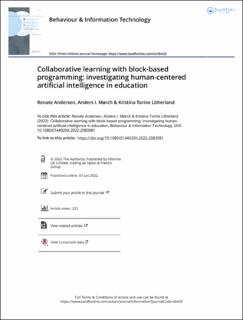| dc.contributor.author | Andersen, Renate | |
| dc.contributor.author | Mørch, Anders | |
| dc.contributor.author | Litherland, Kristina Torine | |
| dc.date.accessioned | 2022-09-27T09:04:12Z | |
| dc.date.available | 2022-09-27T09:04:12Z | |
| dc.date.created | 2022-06-22T22:45:37Z | |
| dc.date.issued | 2022-06-01 | |
| dc.identifier.issn | 0144-929X | |
| dc.identifier.issn | 1362-3001 | |
| dc.identifier.uri | https://hdl.handle.net/11250/3021667 | |
| dc.description.abstract | In this article, we investigate human-centered artificial intelligence (HCAI) in an educational context where pupils used block-based programming in small groups to solve tasks given by the teacher. We used a design-based research approach in which we, together with the teachers, created a maker space for explorative science learning and organised teaching interventions wherein the pupils met online three hours a week for 16 weeks for an entire school year. Due to COVID-19, data were collected through Zoom, with collaborative learning situations captured through screen sharing and online communication using webcams. We employed three data analysis techniques: interaction analysis, visual artifact analysis, and thematic analysis. We developed an analytical framework for integration using thematic coding that combined concepts from computer-supported collaborative learning (CSCL) and domain-oriented design environments. We report the following findings: 1) Three types of rules between design units were identified with visual artifact analysis: latent, generic, and domain-specific rules; 2) two types of CSCL artifacts (technology and discussions) were intertwined and developed in parallel, along with a computer-based scaffolding scenario that offloads domain-specific scaffolding from humans to computers. | en_US |
| dc.description.sponsorship | This research is part of the research project ‘Programming in school’ (ProSkap) funded by Oslo Regional Research Fund in Norway.
This work was supported by the Regional Research Fund of The Research Council of Norway. | en_US |
| dc.language.iso | eng | en_US |
| dc.publisher | Routledge | en_US |
| dc.relation.ispartofseries | Behaviour and Information Technology;Volume 41, 2022 - Issue 9: Democratizing AI | |
| dc.relation.uri | https://www.tandfonline.com/doi/full/10.1080/0144929X.2022.2083981 | |
| dc.rights | Attribution-NonCommercial-NoDerivatives 4.0 Internasjonal | * |
| dc.rights.uri | http://creativecommons.org/licenses/by-nc-nd/4.0/deed.no | * |
| dc.subject | Block-based programming | en_US |
| dc.subject | Computer-supported collaborative learning | en_US |
| dc.subject | Domain-oriented design environments | en_US |
| dc.subject | Human-centered artificial intelligence | en_US |
| dc.subject | Knowledge-based rules | en_US |
| dc.subject | Computing in education | en_US |
| dc.title | Collaborative learning with block-based programming: investigating human-centered artificial intelligence in education | en_US |
| dc.type | Peer reviewed | en_US |
| dc.type | Journal article | en_US |
| dc.description.version | publishedVersion | en_US |
| dc.rights.holder | © 2022 The Author(s) | en_US |
| cristin.ispublished | true | |
| cristin.fulltext | original | |
| cristin.qualitycode | 1 | |
| dc.identifier.doi | https://doi.org/10.1080/0144929X.2022.2083981 | |
| dc.identifier.cristin | 2034389 | |
| dc.source.journal | Behaviour and Information Technology | en_US |
| dc.source.volume | 41 | en_US |
| dc.source.issue | 9 | en_US |
| dc.source.pagenumber | 1830-1847 | en_US |
| dc.relation.project | Regionale forskningsfond Viken: 299053 | en_US |

